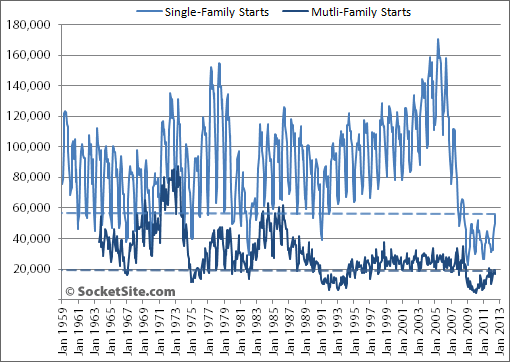
Housing starts in the U.S. increased 6.9 percent from May to June as construction of structures with five or more units jumped 17.0 percent (up 29.1 percent year-over-year) and single-family home starts increased 4.7 percent (up 21.7 percent year-over-year).
Single-family housing starts peaked at 170,400 in May of 2005 and measured 162,800 that June versus 55,400 last month. Multi-family starts which peaked at 87,200 in May of 1973 and measured 75,300 that June were 19,400 last month.
Currently running at a seasonally adjusted annual pace of 76,000, total housing starts have averaged an annual pace of 147,300 since 1959, hitting 227,300 in early 2006 and peaking at 249,400 in early 1972.
On a year-over-year basis, permit activity to start construction was up 19.3 percent in June with applications for multi-family housing up 21.7 percent, up 19.7 percent for single-family homes.
In the west, starts were up 63.4 percent year-over-year, up 33.7 percent for single-family homes while permit activity was up 30.4 percent, up 38.3 percent for single-family homes.
∙ New Residential Construction: June 2012 [doc.gov]
∙ Housing Starts Slip From April To May But Up 28.5% Year-Over-Year [SocketSite]

It is interesting to note that the peak in apartment construction was ~1975, just ~20 years after the peak in Baby Boomer births and the (pre bubble) peak in home construction was ~35 years after he the peak in Baby Boomer births. The “Echo Boomer” births peaked ~1990 but with so many still living at home and so many not even dreaming about buying a home in their 30’s like their parents did I don’t expect a big spike in home or apartment construction.
Good to see that starts are up. Also good to see that the rates have not returned to their historical norm yet. We still have a lot of inventory to consume.
The situation within the 7×7 is entirely different. The city needs a lot more inventory. Absent suppression of SF style anti-development or some Hong Kong style “reclamation” the next best solution is to make the major rail transit nodes outside of the city denser and more city-like.
Bush’s legacy in one simple chart…
“…the next best solution is to make the major rail transit nodes outside of the city denser and more city-like.”
… sadly some of the towns around those transit nodes are resisting change. In this article a Lafayette resident complains that the five story height of a condo building is “staggering” : http://www.contracostatimes.com/news/ci_21256791/condo-plans-near-lafayette-bart-draw-praise-criticism